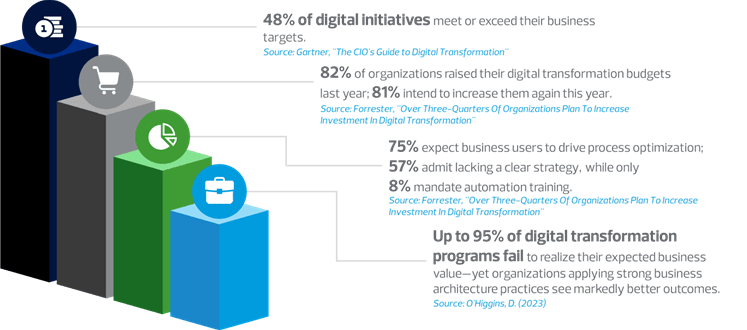Quantitative Facts: The Link Between Digital Transformation and Business Process Redesign
Across industries, digital transformation has moved beyond being a competitive advantage—it's now essential for business survival. In Indonesia, this urgency is even more pronounced. The government's Making Indonesia 4.0 roadmap reflects a clear national ambition: position Indonesia as a global digital economy leader by 2030.
Yet despite substantial investments in digital platforms, cloud adoption, ERP implementations, and AI pilots, many organizations continue to face a sobering reality: the outcomes rarely match expectations. Technology itself is not the core issue. The deeper problem lies in business processes that are outdated, fragmented, or never optimized for a digital operating model.
Independent research highlights this persistent execution gap:

These numbers reinforce a critical lesson: digital transformation fails not because of weak technology, but because organizations attempt to automate processes never designed for the digital era.
Technology Alone Won't Fix Broken Processes
Many Indonesian enterprises have adopted modern ERP systems, cloud platforms, and robotic process automation. But very often, these systems are deployed on top of legacy processes originally designed for different business realities—centralized decision-making, fragmented data ownership, and manual workarounds.
“If you digitize bad process, you only get a faster bad process.” - Michael Hammer
This is why organizations hit the same operational bottlenecks even after their systems go live. Technology amplifies the strengths of well-designed processes—but also amplifies the weaknesses of poorly designed ones.
To truly unlock digital transformation, businesses must fundamentally rethink how their work gets done. This is where Business Process Redesign (BPR) plays a decisive role.
Business Process Redesign: The Often-Overlooked Foundation
Business Process Redesign is not about tweaking existing workflows. It requires organizations to challenge assumptions, break silos, and design operations with digital customers, workforce, and data flows in mind.

Why Digital Transformation Often Stalls Without BPR
We repeatedly see organizations invest heavily in technology but fail to address underlying process complexity. Bottlenecks arise where overlapping responsibilities slow decision cycles. Teams invest time reconciling inconsistent data sets rather than executing high-value work.
Frontline employees continue spending hours on repetitive data entry and manual reconciliations. For customers, this translates into inconsistent service experiences and longer response times.
The result? A highly digitized organization with modern systems—but still struggling with old inefficiencies beneath the surface.
Why BPR Is Central to Indonesia's Digital Agenda
Indonesia's digital ambitions require fundamentally better ways of working. The Making Indonesia 4.0 roadmap outlines ambitious goals across five key sectors: food & beverages, automotive, electronics, textiles, and chemicals. The government's commitment to onboarding 30 million MSMEs into the digital economy by 2024 reflects the scale of change expected.
For both large enterprises and MSMEs, process agility will determine who succeeds in this digital economy. With BPR embedded early in the transformation journey, organizations can:
- Build lean, scalable processes fit for digital scale
- Realize stronger returns on technology investments.
- Deliver consistent customer experiences.
- Enable faster, insight-driven decision making.
CONCLUSION: TURNING DIGITAL AMBITIONS INTO COMPETITIVE ADVANTAGE
Digital transformation is business transformation. To achieve meaningful digital transformation, focus not only on adoption of technology, but also on process redesigning the architecture that enables organizations to unlock real business impact. Consider the following steps:
- Assess existing processes to understand current performance and identify pain points.
- Identify inefficiencies that may be limiting growth or agility.
- Redesign processes to be flexible and future-ready, aligned with broader digital goals.
- Develop a practical, phased transformation roadmap to guide implementation and measure progress.
By Adhitya Ibarda Putra, Technology Consulting Practice

